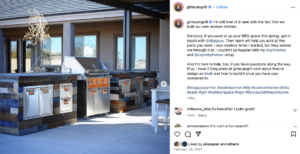Market Overview
The outdoor cooking market has seen significant growth since the onset of the pandemic in 2020, and this trend shows no signs of slowing down. According to a recent Outdoor Cooking research study from Mintel, over 66% of U.S. adults are enthusiastic about outdoor cooking, investing in durable and user-friendly appliances and equipment.
This surge in outdoor cooking is driven by a combination of warmer weather and a heightened focus on health. Cooking outdoors not only fosters social interaction but also enhances both physical and mental well-being by encouraging the preparation of delicious, home-cooked meals. Despite rising grocery prices, consumers are opting to cook at home, recognizing the long-term health benefits and cost savings. Gas grilling remains the top choice for outdoor cooking, with charcoal and pellet grills following closely behind.
Target Consumer Demographics
While brands traditionally target dads as the primary outdoor grilling demographic—accounting for 47% of outdoor cooks—there are emerging audiences that brands should not overlook:
Women
Women’s involvement in outdoor cooking is on the rise, presenting a valuable opportunity for brands. Many women remain untapped consumers, and targeted marketing campaigns can effectively engage this demographic. Showcasing women in grilling scenarios—like “Girls Can Grill,” led by award-winning pitmaster Christie Vanover—can inspire interest and demonstrate that grilling is accessible to everyone. Our team at Ramey brought Christy on as an ambassador for Aspire by Hestan and saw impressive engagement with her content.

Younger Generations
The younger demographic, particularly those aged 27-45, may be new to outdoor grilling, but they are eager to participate. Of this group, those with more disposable income are more likely to invest in outdoor cooking equipment. Notably, Millennials and Gen Z are projected to account for 80% of the global luxury market by 2030, presenting a significant opportunity for brands to connect with them now and cultivate long-term loyalty.
Strategies for Engaging Consumers
To effectively engage today’s customers, brands should focus on three key areas: dynamic social media campaigns, seamless purchasing experiences, and ongoing community building
- Social Media Engagement: 88% of younger consumers rely on social media for their purchasing decisions, making it an essential platform for fostering loyalty, and interaction. Brands can leverage both organic and paid media campaigns that emphasize storytelling and brand identity, creating a compelling narrative that resonates with this audience.
- Leverage E-commerce Shopping, Online Reviews and Testimonials: While in-store shopping remains popular, nearly half of consumers now prefer online shopping. As they navigate their purchasing journeys, consumers increasingly depend on reviews and testimonials. Brands should enhance their online presence by showcasing positive reviews, enabling live chat support for immediate assistance, and streamlining the ordering process for convenience.
- Build a Community and Brand Advocacy: Some businesses consider a purchase to be the end of their sales cycle with a customer, but the customer journey must continue if you want to grow brand advocacy. Post-purchase, it’s crucial for brands to maintain communication and cultivate a sense of belonging among their audience. This can be achieved through YouTube channels, podcasts, newsletters, and other long-form content that engages and informs. Creating a community of fans can enhance brand loyalty and encourage repeat business.
Outdoor cooking brands have a unique opportunity to capitalize on the growing interest in this market by diversifying their target demographics and enhancing the purchasing experience. At Ramey, we bring decades of expertise in the expanding outdoor market. From launching brands to crafting innovative digital marketing strategies, we’re dedicated to pushing the envelope and delivering top KPIs for our clients.


